BEST PRACTICES FOR BICYCLE AND DRIVER SAFETY
The following scenarios will help guide you in situations you may experience on the road as a bicycle rider or driver.
Scenario 1 | Approaching an intersection or driveway as a bicycle rider

Bicycle approaching vehicle at intersection or driveway.
Best Practices
• Obey all traffic laws.
• Be visible and predictable at all times. Make eye contact with other drivers.
• Practice proactive positioning: think ahead to where you need to be positioned for your next move.
• You may walk your bike across a crosswalk or intersection if you are uncomfortable riding across.
• Use the rightmost lane going in the direction you are traveling.
• Be aware that drivers may not see you, especially if there are parked cars or other obstructions.
• Use the rightmost lane going in the direction you are traveling.
• Be aware that drivers may not see you, especially if there are parked cars or other obstructions. Make eye contact with the driver. Use hand signals to indicate if you are turning.
Scenario 2 | Turning left at an intersection or driveway as a bicycle rider
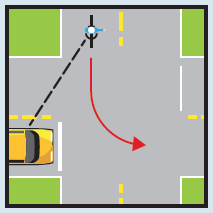
Bicycle rider turning left at an intersection or driveway.
Best Practices
• Position yourself in the middle of the left-most lane (or in the case of a dual left, in the right-most left turn lane). If you are too far left, a vehicle may pull up beside you and crowd your turn.
• You may also choose to walk your bike and cross the intersection or driveway as a pedestrian.
• Use hand signals to indicate your intention.
• Watch for pedestrians.
Scenario 3 | Turning right at an intersection or driveway as a bicycle rider
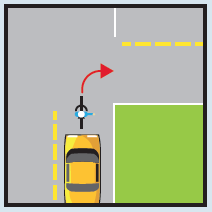
Bicycle rider turning right at an intersection or driveway.
Best Practices
• Position yourself in the middle of the right-most lane (or right-most right turn lane).
• Be aware that if you are too far right, a vehicle may pull up beside you and crowd your turn.
• Use hand signals to indicate your intention.
• Watch for pedestrians.
Scenario 4 | Traveling straight through an intersection or driveway as a bicycle rider
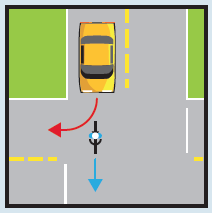
Bicycle rider traveling through an intersection.
Best Practices
• Position yourself in the middle of the right-most lane going in the direction you are traveling.
• Be aware that if you are too far right, a vehicle may try to make a right turn in front of you.
• Be aware that oncoming drivers turning left may not see you.
• Pass right turning vehicles on the left side. This may require you to leave the bike lane or shoulder.
Scenario 5 | Driver approaching an intersection or driveway

Driver approaching an intersection, bicyclist on the right.
Best Practices
• Be aware of bicyclists and watch for hand signals or head turns.
• Remember to treat the person on the bicycle as another road user.
• At four-way stops, bicyclists are treated the same as motor vehicles.
• Maintain three feet of separation between your vehicle and a bicyclist.
Scenario 6 | Driver turning left an intersection or driveway
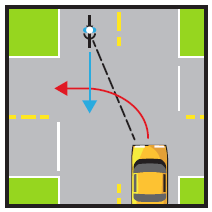
Driver turning left at an intersection, bicyclist approaching.
Best Practices
• Be predictable. Use your turn signals to indicate your intention to turn.
• Watch for oncoming bicyclists (and pedestrians) before and as you turn.
• Make eye contact with the person on the bicycle.
• Square your turn for optimal visibility of bicyclists and pedestrians.
Scenario 7 | Driver turning right an intersection or driveway
Driver turning right at an intersection, bicyclist on the right of vehicle.
Best Practices
• Watch for bicyclists to your right as you are turning — check your mirrors and glance over your shoulder.
• Make eye contact with the person on the bicycle. Look for clues to help determine the direction they are going.
• Turn from the curb. Turn from the right-most lane, even if the right-most lane is a bike lane or shoulder.
• If you must cross a bike lane to enter a right turn lane, yield to any bicyclists in the bike lane.
Scenario 8 | Driver pulling out from an intersection or driveway
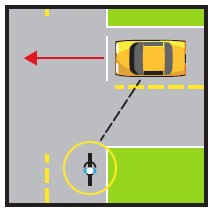
Driver pulling out from an intersection, make eye contact with bicyclist at intersection.
Best Practices
• Carefully approach the intersection looking to your left for bicyclists as well as cars and pedestrians.
• Stop in advance of the crosswalk area (may be marked or unmarked) to yield to others before proceeding.
• Yield the right-of-way to a bicycle when appropriate, just as to any other motor vehicle.
Scenario 9 | Riding with or without bike lane/shoulder
Bicyclist riding on the road, allow 3 ft. space between vehicles.
Best Practices for bicyclists
• Ride in the same direction as traffic and as far right as practical. Utilize bike lanes or shoulders when available.
• If the road is narrow with no bike lane or shoulder, in most situations it is best to ride in the middle of the lane (or take the lane) until it is safe to pull to the right and allow traffic to pass.
• Place yourself a minimum of three feet away from traffic.
• Be predictable. Point to where you are going so motorists know what you want to do.
Scenario 10 | Riding next to vehicles parked along the street
Bicyclist riding on the road, allow 3 ft. space between vehicles. Be aware doors opening from parked cars.
Best practices for bicyclists
• Be alert for vehicles pulling in or out of parking spaces.
• Ride far enough over (maintain three feet distance) to avoid an opening car door.
• Watch your speed. Drivers may not see you when pulling out.
• Ride in a straight line instead of weaving in and out around parked vehicles.
Scenario 11 | Driving near a bicycle with or without bike lane/shoulder

Bicyclist riding on the road, allow 3 ft. space between vehicles.
Best practices for drivers
• Maintain three feet between your vehicle and the bicyclist.
• Be patient. If the lane is narrow, wait until there is a safe distance to pass.
• Bicyclists have the rights and duties of other vehicle operators. Remember to yield the right-of-way to a bicyclist when appropriate, just as to any other vehicle.
Scenario 12 | Using on-street parking

Bicyclist riding on the road, allow 3 ft. space between vehicles. Don’t park in bicycle lanes.
Best practices for drivers
• Look twice for bicycles when parking along a street and when opening doors.
• Use your mirrors and check over your shoulder for passing cars and bicyclists.
• Take extra care when leaving a space. If necessary, ask someone to help you with spotting traffic.
• Don’t park in a bicycle lane. Although it may not be specifically prohibited, parking in a bike lane blocks the lane for the intended users.



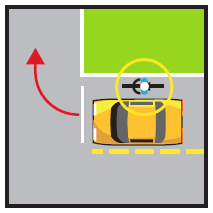
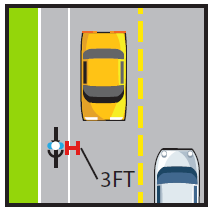

Join the Ride!